Creating Eye-Catching Etched Plates Design Tips and Tricks
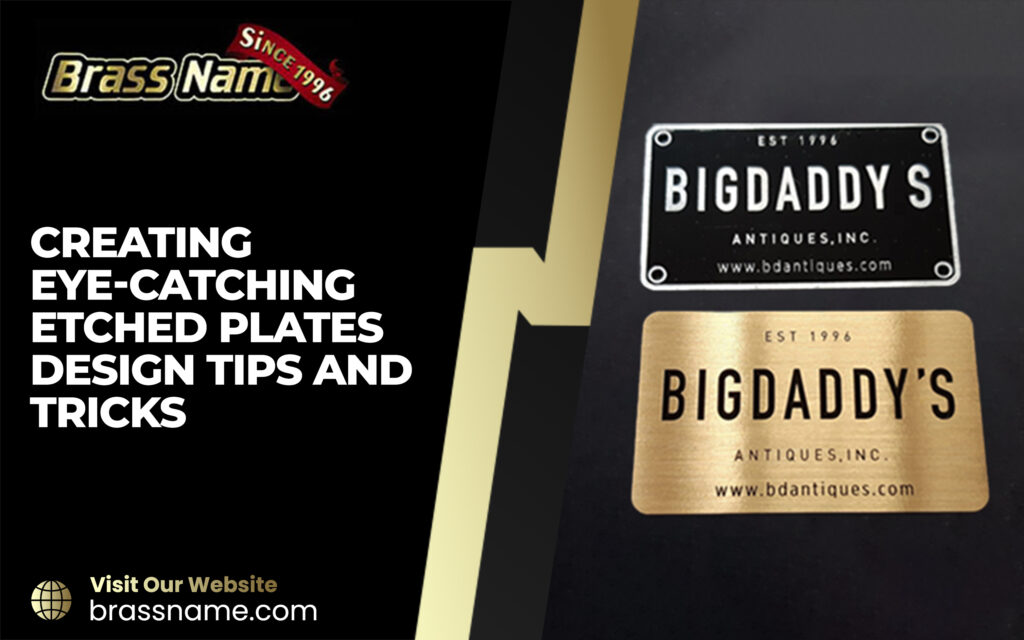
Etched plates are a stunning way to add a touch of personalization and artistic flair to your home decor, tableware, or even gifts. The process itself is surprisingly accessible, allowing you to transform ordinary plates into beautiful works of eye-catching metal art. But where do you begin? This blog is your one-stop guide to creating eye-catching etched plates! We’ll delve into everything you need to know, from brainstorming design ideas and choosing the perfect plate to exploring various etching techniques and discovering tricks to make your design truly shine. So, find out where to buy etching supplies, grab your creative spark, and get ready to transform those plain plates into masterpieces! What is Etching? Have you ever been captivated by the rich, velvety lines of an antique print? That subtle depth and detail is often the result of etching, an artistic technique with a fascinating history. Etching goes beyond simply creating a design; it’s about etching your mark onto a surface, literally and figuratively. At its core, etching is an intaglio printmaking process. Imagine a metal plate coated in a special acid-resistant barrier, like a protective shield. The artist then takes on the role of a sculptor, using a sharp tool to scratch away sections of this barrier, revealing the bare metal beneath. This exposed metal becomes the stage for the magic to happen. The metal plate is submerged in an acid bath, and just like a sculptor carving away at the stone, the acid meticulously eats away at the exposed metal, creating a network of incised lines and textures. The beauty of an etched plate design lies in the level of control the artist wields. The depth and width of these etched lines depend on the duration of the acid bath, allowing for a captivating range of tones and textures. Once the etching is complete, the plate transforms into a printing tool. Ink is pressed into the etched grooves, becoming deeply embedded within them. When the plate is pressed against damp paper, the ink transfers, leaving behind a mirror image of the etched design. The History of Etching The origins of etching can be traced back to the sixteenth century, but it wasn’t until the seventeenth century that it truly came into its own. Jacques Callot, a visionary printmaker, revolutionized the technique with his inventive tools and methods, paving the way for future artistic exploration. However, it was the mastery of artists like Rembrandt van Rijn that elevated etching to new heights. Rembrandt’s skill-full manipulation of light and shadow, coupled with his dynamic storytelling, established etching as a medium capable of profound expression. Throughout the centuries, etching continued to captivate artists across diverse genres and styles. From the satirical commentary of William Hogarth to the architectural marvels of Giovanni Battista Piranesi and the social critique of Francisco Goya, etching served as a versatile canvas for artistic innovation. Even in the modern era, luminaries like Pablo Picasso and Käthe Kollwitz embraced etching, infusing it with new perspectives and pushing its boundaries. Today, artists like Norman Ackroyd carry on this tradition, ensuring that etching remains a vibrant and enduring form of artistic expression. Different Types of Etching Etching isn’t a one-size-fits-all process. There are several techniques suited for different materials and artistic goals. Here’s a breakdown of some common etching types: Chemical Etching: This traditional method uses acid solutions to create designs on a surface. A protective resist is applied to the material, and the artist scratches away sections to expose areas for etching. The material is then submerged in an acid bath, which eats away at the exposed areas, creating a permanently etched design. Chemical etching works well on glass, metal, and even some plastics. Electrolytic Etching: This method utilizes electricity to achieve similar results to chemical etching. The material is submerged in an electrolyte solution, and an electrical current is passed through it. The exposed areas react with the electrolyte, creating the etched design. Electrolytic etching offers more precise control over the etching depth compared to chemical etching, making it ideal for intricate details. It’s commonly used for glass and metal. Dry Etching: Unlike the previous methods that use liquid solutions, dry etching employs a gas plasma to remove material. A stencil or mask is used to define the desired pattern on the surface. The material is then bombarded with ions in a vacuum chamber, etching away at the exposed areas. This method offers excellent precision and is often used in microfabrication for creating circuits on silicon wafers. Laser Etching: This modern technique uses a focused laser beam to vaporize material from the surface, creating a permanently etched design. It offers exceptional control and detail but requires specialized equipment and can be more expensive compared to other methods. Laser etching is versatile and can be used on various materials like metal, glass, plastic, and even wood. These are just some of the most common etching techniques. The choice of method depends on the desired outcome, material, and budget. Each technique offers unique advantages and limitations, allowing artists and manufacturers to create a vast array of etched designs. Decorative Etching Techniques Etching goes beyond simple lines; it’s a canvas for artistic expression. Here are some decorative techniques to elevate your etched plates: Geometric Patterns: Embrace the precision of geometric designs. Use stencils for clean lines and shapes, or create freehand patterns using rulers and etching tools. Play with scale and repetition for a modern and captivating look. Nature’s Inspiration: The natural world is brimming with etching inspiration. Capture the delicate veins of leaves, the graceful curves of flowers, or the majestic silhouette of animals. These organic forms add a touch of elegance and beauty to your plates. Mandalas & Zentangle Art: For a touch of meditative intricacy, explore the world of mandalas and Zentangle art. These techniques involve creating intricate patterns using repetitive shapes and lines. They’re perfect for adding depth and detail to your etched designs. Textured Effects: Don’t limit yourself to smooth lines! Experiment with textured effects
DIY vs. Professional Embossed Name Plates: Pros & Cons
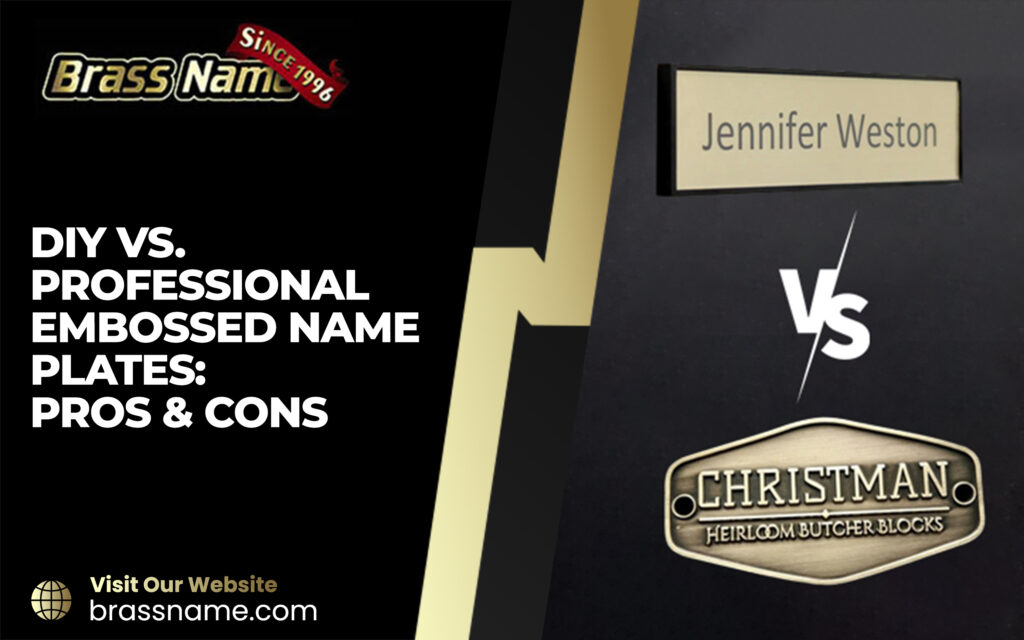
Forget the plain mailbox label – a custom-embossed nameplate is the epitome of sophistication. More than just identification, these carefully crafted embossed house number signs are mini works of art, symbolizing a high level of craftsmanship and engineering accuracy. From the sleek branding of a corporate office to the warm welcome on a family home, embossed nameplates serve as the foundation for identity and aesthetics in countless industries, from aerospace to hospitality. But when it comes to creating your statement piece, the question remains: DIY or buy professional? This blog dives into the pros and cons of both approaches, helping you decide which path is right for your budget, skills, and desired outcome. What Is Embossing? Embossing is a transformative technique that gives metal surfaces a distinctive raised design or lettering. This process creates a three-dimensional image that’s not only visually striking but also adds a tactile element, making it stand out to customers. Industries like automotive, product manufacturing, and furniture often utilize embossing on their nameplates and decals to make their products more eye-catching and to convey important information like weight, directions, and brand messaging more effectively. Beyond its aesthetic appeal, embossing serves practical purposes, providing both visual and tactile cues that enhance the overall user experience. It’s a way for businesses to add a touch of craftsmanship and quality to their products, distinguishing them from competitors in a crowded market. In essence, embossing is more than just surface decoration; it’s a strategic tool that helps businesses communicate their brand identity and product features clearly and memorably to customers. How Embossing Works Embossing metal nameplates involves a meticulous process that combines precision and craftsmanship. It begins with custom dies, carefully crafted to leave a distinct impression on the metal substrate. These dies, one with raised engraving and the other with a corresponding sunken copy, work together to create the desired effect. During embossing, the metal substrate is placed between these dies and subjected to significant pressure from a machine press. This pressure forces the metal into the engraved patterns on the dies, resulting in a raised design or text on the surface. The outcome is a visually striking three-dimensional effect that enhances the appearance of the nameplate. One of the remarkable aspects of embossing is its adaptability. Beyond the basic process, various finishing techniques can be applied to further customize the appearance of the nameplate. Options like brushed or milled finishes offer different aesthetic choices, allowing businesses to tailor the final look to their preferences. Pros and Cons of Embossed Nameplates Embossed nameplates transcend mere identification; they’re testaments to meticulous craftsmanship and brand identity. But before diving into the DIY vs. professional debate, let’s explore the inherent advantages and limitations of the embossing process itself. Pros: Enhanced Visibility & Heightened Brand Recognition: Embossing elevates your nameplate beyond a flat surface. The raised text and imagery create a captivating 3D effect, making it stand out from its surroundings. This translates to improved user awareness; a potential customer is more likely to register and remember a company logo or name that pops out at them. Think of it as branding that gets noticed. Unexpected Durability: One might assume embossing weakens the material. However, the process has a surprising benefit – it strengthens the final product. The metal softens during embossing, but upon cooling, it hardens and gains additional resilience. This makes embossed nameplates ideal for harsh environments, from the scorching desert sun to the biting winter wind. They’ll weather the elements while maintaining their crisp appearance. Cons: Limited Design Flexibility: Embossing excels at creating sharp, well-defined lines and text. While some intricate designs are achievable, it’s not ideal for highly detailed graphics or photographs. If your vision involves complex imagery, other techniques like engraving or laser etching might be better suited. Potential for Higher Costs: Compared to simpler printing methods, embossing requires specialized equipment and skilled labour. While still a worthwhile investment for the quality and longevity it offers, this translates to a higher initial cost. In conclusion, embossing offers a compelling combination of visual appeal and long-lasting durability. However, it’s important to consider the limitations in design complexity and the potential for increased cost when making your decision. DIY vs Professional Nameplate – Which is Better? The allure of a handcrafted embossed name plate is undeniable, but the question remains: should you tackle it yourself or entrust it to a professional? Both approaches offer unique advantages, but there are a few considerations to make before you choose the best route. DIY Embossed Nameplate – Unleash Your Creativity Your doorstep is the first glimpse visitors get of your home, and a customized name plate sets the tone for the entire ambiance. Looking to create a lasting impression? Consider crafting your DIY nameplate – a budget-friendly way to express your unique style. Pros: Budget-Friendly: DIY projects are significantly cheaper than commissioned pieces. You can choose the embossing tools for nameplates as per your budget to avoid additional costs and markups. Customization Freedom: Unleash your creativity! You have complete control over the design, size, and materials used. Sense of Accomplishment: There’s a unique satisfaction in crafting your own nameplate – a testament to your skills and individuality. Cons: Time Commitment: Learning the embossing technique, gathering materials, and completing the project can be quite time-consuming. Skill Level: While some DIY embossing methods are beginner-friendly, achieving a polished, professional look might require some crafting experience. Limited Tools: Certain techniques require specialized materials for DIY embossed nameplates that can add to the overall cost. Durability Concerns: DIY nameplates, especially those made with softer materials, might not be as weatherproof or long-lasting as professionally made ones. Professional Expertise: Convenience and Quality Craving a touch of timeless elegance for your entryway? Look no further than professionally embossed nameplates. These meticulously crafted signs go beyond simple identification, adding a layer of sophistication and craftsmanship that speaks volumes about your home. With a customized plaque done by professional embossed nameplate services, you’re not just welcoming guests – you’re creating
Etched Plates vs. Engraved Plates: Understanding the Differences
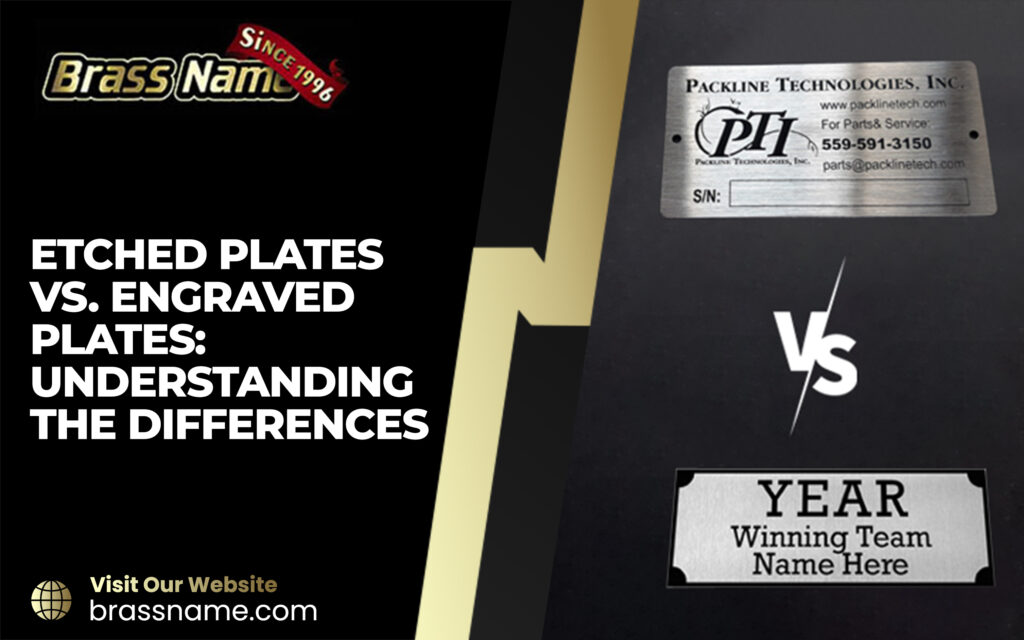
Choosing the right nameplate involves considering various elements, from its dimensions to the method of marking. Among the plethora of options available, etched and engraved nameplates stand out as top contenders. Although these two share similarities, their manufacturing processes diverge significantly. Understanding these disparities is crucial in making an informed decision about which type of nameplate best suits your needs. At Brass Name, we pride ourselves on guiding you through the selection process, helping you discern whether an etched or engraved nameplate is the optimal choice for your requirements. Here, we go out of our way to ensure a seamless and satisfactory experience with your custom nameplate. In this blog, we dive into the intricate details of etched and engraved plates, examining their differences in manufacturing processes, appearance, durability, and suitability for various applications. Armed with this knowledge, you’ll be empowered to make the right choice for your specific needs. What Is Engraving? Engraving, whether on wood blocks or metal plates, embodies a meticulous artistry where images are carefully carved to create stunning impressions. In woodblock engraving, artists intricately carve designs into wooden surfaces, applying ink to the raised areas for printing. Conversely, metal plate engraving utilizes the intaglio technique, incising designs into metal surfaces, with ink settling into recessed grooves for transfer onto paper. Each method offers distinct visual appeal, with wood engravings boasting a white-on-black aesthetic and metal plate engravings renowned for intricate detail. Both techniques exemplify timeless craftsmanship, inviting viewers to appreciate the artistry and precision behind each print. What Is Etching? Etching, rooted in tradition, involves the meticulous incision of designs into metal surfaces using acids or mordants, a process that has evolved with modern chemical applications. Its historical significance persists in printmaking, complementing engraving as a cherished technique in old master prints. Beyond its artistic heritage, etching plays a crucial role in contemporary technologies, contributing to the production of circuit boards and microfabrication processes. This enduring craft bridges the gap between tradition and innovation, leaving an indelible mark on both artistic expression and technological advancement. Etched vs. Engraved Plates Despite yielding similar final products, etching and engraving differ significantly in their technical processes and results. Laser engraving, for example, operates by creating a hollow within a material’s surface, resulting in an image or message that’s both visible and tactile. In contrast, laser etching removes the top layer of material, akin to a gentle erosion, without causing structural damage. Some major considerations to make while differentiating the two include: Variety in Aesthetic and Design Options Whether opting for etched or engraved nameplates, the breadth of design possibilities allows for the incorporation of logos, graphics, or text. Etched nameplates feature smooth, evenly engraved grooves, ideal for showcasing intricate patterns and fine details. In contrast, engraved nameplates possess distinctive textural qualities, characterized by deep etching that adds depth and texture to the finished artwork. Selection of Materials Nameplates, whether etched or engraved, are commonly crafted from a diverse array of materials, including metals like aluminum, stainless steel, and brass, as well as plastics such as acrylic and PVC. The choice of material for a nameplate hinge on considerations such as strength, aesthetics, and environmental conditions. Durability of Etched vs Engraved Plates: Both etched and engraved metal nameplates are engineered to withstand wear and tear, including abrasion and corrosion. However, their long-term performance may vary depending on factors such as exposure to harsh environments, frequency of use, and maintenance practices. Cost Comparison: Etching vs. Engraving: When it comes to choosing between metal etching vs engraving, cost considerations can play a significant role in your decision-making process. Several key factors influence the cost disparity between these two techniques, each impacting the overall expense of your project. Material: Hard materials like stainless steel or titanium pose more challenges for engraving, driving up the cost due to increased labour and time requirements. In such cases, we typically lean towards recommending chemical etching, which offers a more cost-effective solution without compromising on quality. Character Size and Depth: The intricacy of your design, especially when it comes to text or fine details, directly affects the complexity of the etching or engraving process. Naturally, the more intricate the design, the higher the cost, as it demands greater precision and attention to detail. Production Volume: For small-scale projects requiring only a few labels or nameplates, engraving may sometimes be the more economical choice. However, for larger volume orders, etching often proves to be the more cost-effective option, thanks to its efficiency and scalability. At Brass Name, we believe in transparency when it comes to pricing, ensuring that you have a clear understanding of the cost implications before proceeding with your project. For instance, if you’re eyeing a stainless-steel label with small text, we’ll steer you toward chemical etching for its ability to deliver the same high-quality results in less time and at a lower price point. Considerations Tailored to Your Application Your product’s specific requirements can play a pivotal role in determining whether etched or engraved nameplates are the optimal choice. Applications for etched plates often excel in industrial settings where durability and readability are paramount, whereas applications for engraved plates prioritize originality and individuality. Environmental Responsibility and Sustainability Increasingly, environmental impact and sustainability considerations weigh heavily on decision-making processes. Both etched and engraved nameplates can be manufactured using eco-friendly materials and processes, making them environmentally friendly alternatives. By carefully evaluating these factors and leveraging our expertise, we can help you make informed decisions that not only meet your budgetary constraints but also exceed your expectations in terms of quality and craftsmanship. Depth of Etching vs Engraving: Evaluating the Pros & Cons While etching offers precision and subtlety in surface modification, engraving excels in creating deeper, more tactile impressions. Evaluating the pros and cons of each method provides valuable insights for choosing the optimal approach based on project requirements and desired outcomes. Engraved Plate Pros and Cons When considering incorporating engraving into your project, it’s essential to weigh both its advantages and limitations. Let’s explore
Understanding the Process of Creating Custom Embossed Badges
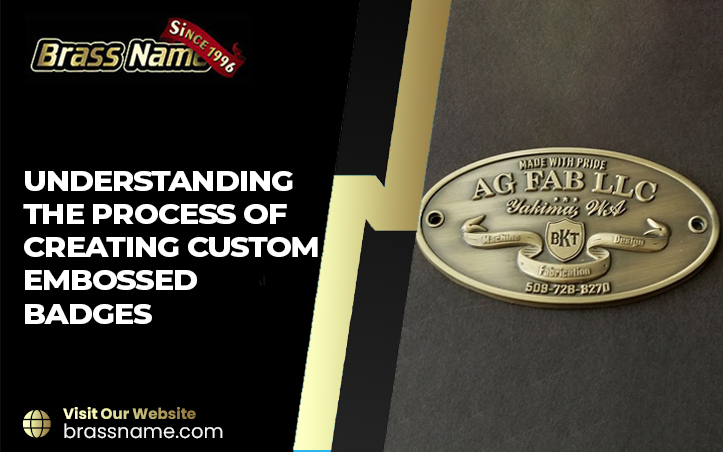
Designing the Badge The journey of a custom embossed badge begins with a well-thought-out design. Precision is critical, whether a logo, name, or any other artwork. We can help you create designs for embossed badges and metal tags with your Logo at no extra charge. Practically FREE Design for you! Our designers work closely with our clients to ensure the badge accurately reflects their brand identity or personal preferences. We would also provide a Free Virtual sample, the closest look of your future 3D embossed badge in digital version. We can also provide real physical samples for you to touch and feel the difference between our embossed badges. Finally, if you want an original 3D sample of your badge to evaluate your project, we would be happy to provide it for the price of Mold. Material used for Embossed Badges and 3D metal nameplates Benefits of Using Custom Embossed Badges Custom embossed badges offer a myriad of benefits: Professionalism: They add a touch of professionalism to any attire or setting. Durability: High-quality materials ensure longevity, making them ideal for long-term use. Customization: Clients can design badges according to their preferences, allowing for unique and personalized creations. Applications of Custom Embossed Badges Corporate Branding Custom embossed badges serve as powerful branding tools for businesses. Identification Purposes Custom embossed badges offer visually appealing ways to identify your company and your products. Their tactile nature makes them easy to distinguish, even from a distance. Factors to Consider When Ordering Custom Embossed Badges Luxury Feel of Your Brand Consider that all industry leaders use this type of badge for their products. We don’t have to produce tens of thousands of badges with your Logo to get you into the same club! You can reserve your custom 3D embossed badge with our FREE design and orders as low as 500 or even 250 pcs for a low competitive price! Material Durability Durable materials used for these 3D badges and the highest quality electroplings will ensure use in literally any environment. Budget Considerations Balancing quality with budget is crucial when ordering custom embossed badges. While high-quality materials and intricate designs may come at a higher cost, they offer long-term value and visual impact.New technologies such as 3D modeling and 3D printing allow us to craft the Mold with your Logo for a fraction of the price charged just a few years ago for the same job. We have thousands of returning, satisfying customers as the best reference for their and our success in this business! Different Types of Embossing Techniques Embossing techniques vary depending on the desired effect: Mask Embossing: Creating a raised design usually without additional color or plating. Mold Injection Embossing: Hot, molten metal Injection molding using alloys of zinc and copper in a proper ratio that is required with the type of finish Multi-Level Embossing: Creating multiple levels of depth and detail for intricate designs. Conclusion Custom embossed badges offer a unique blend of style and functionality, making them indispensable assets for businesses. With fantastic-looking corporate branding these badges leave a lasting impression while serving practical purposes. With a wide range of customization options and durable materials, they stand the test of time, making them a wise investment for your business. FAQs (Frequently Asked Questions) How durable are custom embossed badges? Custom embossed badges are highly durable! Can I order 1 custom embossed badge with my Logo or company name? Yes, you can! For the price of Mold production and shipping, you can see your 3D Logo badges to evaluate the design & quality for the bulk order. How much is Custom Mold? For the smaller size badges (range up to 3” x 2”) price per mold can be from US $ 150 to US $ 330 ; What is the typical turnaround time for custom embossed badges? Usually, 4-5 weeks as we need to craft a custom Mold according to your Logo first and then work in bulk production after all we need to electro-plate them to achieve the requested finish. Are custom embossed badges suitable for outdoor use? They will maintain the same appearance after decades of outdoor exposure! Can we add our company colors for our embossed badges? Yes, we can add custom PMS paint around certain embossed parts!
What Are Etched Nameplates?
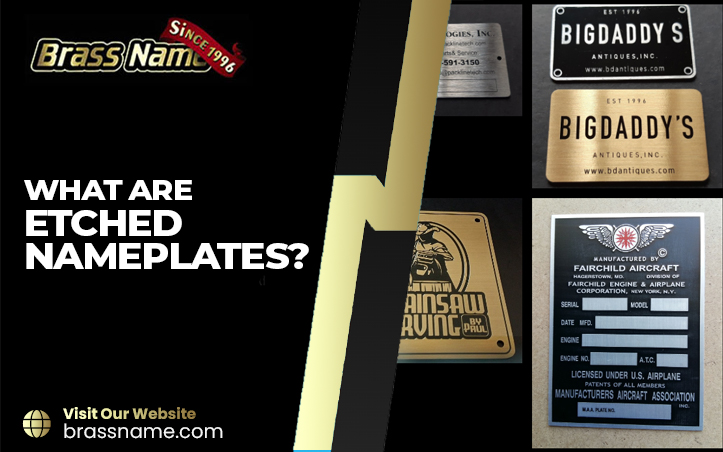
Etched nameplates are custom metal plates typically made from brass, aluminum, or St. steel featuring recessed or raised designs, text, or logos. This process involves selectively removing material to create raised or recessed designs, resulting in a permanent, high-quality finish. Materials Used in Etched Nameplates Metal: Metallic nameplates offer unparalleled durability and a classic aesthetic. Typical metals used for etched nameplates include stainless steel, aluminum, and brass. Advantages of Etched Nameplates Durability for the lower price Etched nameplates resist fading, scratching, and corrosion, ensuring longevity even in challenging environments Customization Options Intricate designs and precise detailing can be achieved with etching techniques, allowing for unique branding opportunities, multiple customization, and serialization along with barcode capabilities Professional Appearance Etched nameplates include professionalism and attention to detail, making them ideal for showcasing brand identity and enhancing product aesthetics. Applications of Etched Nameplates Etched nameplates find extensive use in various industries and settings: Industrial Equipment: Labeling machinery, control panels, and components. Identification Tags: Utilized for asset tagging, serial numbering, and safety labels and tags. Etching Techniques Two primary etching techniques are commonly used: Chemical Etching: Involves using acids or etchants to selectively remove material from the surface, leaving behind the desired design. Laser Etching: Utilizes a laser beam to vaporize or melt the material, creating precise, permanent markings. Factors Affecting Cost: Material choice, size, thickness, quantity, and type of finishes ordered nameplates influence pricing more than design. We can provide a price in most cases just according to the chosen material, size & thickness, and quantity. Fine tunes in the quotation process are based on design/production requirements and the type of plating or finish. Types of attachments – like types of screws, pins, or adhesives are also important to finalize quotation for the project. Conclusion Etched nameplates offer a durable, customizable solution across industries for branding and identification needs. With various materials, design options, and etching techniques, businesses can create distinctive nameplates that enhance their identity leave a lasting impression, and provide lasting durability for a lower price. FAQs (Frequently Asked Questions) Are etched nameplates suitable for outdoor use? Yes! Etched Brass and Aluminum especially stainless steel are suitable for outdoor applications. Can I order custom shapes for my nameplates? We can provide custom shapes for the same price as rectangular or oval plates of the same overall size to suit your specific design requirements. How long do etched nameplates typically last? Etched nameplates can last decades without losing quality or appearance. Are there any restrictions on the size of etched nameplates? While there may be size limitations depending on the material, and thickness we can accommodate a wide range of sizes. Can etched nameplates be used for serialized numbering? Etching allows for precise numbering and serialization and for barcode or QR code etching making it suitable for asset tagging and identification.
Brass Name Co. Custom & Elegant Metal Name Plates, Personal Badges, and small Office signs open the world of possibilities with better quality, lower prices, and improved visual communication
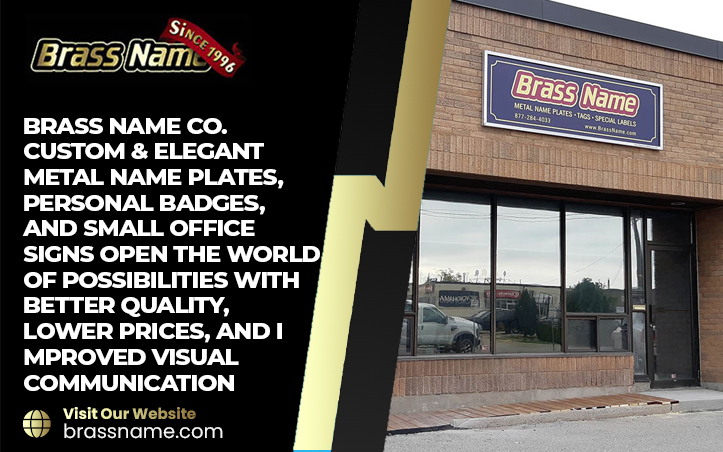
History and Significance Brass has been utilized for centuries due to its durability and attractive appearance. The use of brass nameplates dates back to ancient civilizations, where they were employed for labeling purposes in various contexts, including households, businesses, and public institutions. Later, more expensive brass is replaced with Aluminum, silver, and Gold / Brass plated and we are still using solid brass along with new, signs, nameplates, and badges produced on Aluminum. Materials and Manufacturing Process Aluminum nameplates are crafted with the highest quality and pure Aluminum and Brass nameplates are typically made from an alloy of copper and zinc, providing a blend of strength and corrosion resistance. Types of Office Name Plates Traditional Engraved & Etched Name Plates Traditional brass nameplates were often engraved with text or designs using specialized tools. This method is still in use by many engravers but it’s not always functional to produce modern-style typefaces or logos and engraving is especially not efficient with longer and finer text parts. Photochemical Etching can handle most of these problems but still can not reduce the cost of these old methods of markings and producing nameplates. We are still using Photo chemical Etching on Brass, Aluminum, and Stainless Steel for the production of industrial & commercial engraved & etched nameplates and for larger nameplate orders but for smaller sizes and individual nameplate orders we have adopted newer printed methods.and we have replaced traditional engraving and etching with Personalized name plates, small office signs, and name badges with Modern Digitally Printed Name Plates Our custom digitally printed full-color plates on white, silver, or brass plated (gold) aluminum are faster and more clear ways of production and way more cost-effective than traditionally engraved brass plates.Digitally printed plates can have high-quality Logos produced in high-resolution, full-color images and even photos that are durable and scratch-resistant on metal. Nameplates produced using the digital printing process are resistant to fading, peeling, and cracking, making them suitable for cleaning and resistant to tarnishing or changes preserving the message and easy to maintain. In a fast and vibrant office environment, changes are imminent and necessary and signage needs to follow the paste, look, and functionality of modern business space and needs to be easy to maintain and replace when necessary. Applications of Brass Name Co. Plates: Aluminum & Brass nameplates find a multitude of applications across various sectors: Commercial Use: In commercial establishments, custom nameplates are employed for office signage, desk nameplates, and directional signs, contributing to a professional and polished ambiance. Industrial Use: In industrial environments, brass nameplates, aluminum, and St. steel nameplates and tags, asset labels, and machine identification plates, provide durable and reliable identification solutions. Customization Options Metal nameplates offer extensive customization options, including font, size, shape, and finish. Additionally, customers can opt for personalized messages to reflect their unique style and preferences. Maintenance and Care Tips Regular cleaning and polishing are essential to maintain the luster and longevity of metal nameplates. Mild soap and water can remove dirt and grime, followed by a polish to restore shine. Avoid abrasive cleaners or harsh chemicals, which may damage the surface. Advantages of Metal Name Plates Durability: Metal, Aluminum, St.Steel and Brass nameplates are highly durable and corrosion-resistant, ensuring long-term reliability. Customization: Metal, Aluminum, St.Steel, and Brass nameplates offer extensive customization options, allowing individuals to create personalized designs. Prestige: Metal, Aluminum, St.Steel, and Brass are often associated with luxury and prestige, making metal, aluminum & brass nameplates popular for upscale applications. Disadvantages of Brass Name Plates Cost: Brass nameplates are more expensive than alternatives such as aluminum or plastic. Maintenance: Brass requires regular cleaning and polishing to maintain its appearance, which can be time-consuming. Weight: Brass is heavier than other materials, which may affect installation and transportation.Aluminum digitally printed nameplates answer most of these questions and often are the main reason for the replacement of traditionally engraved brass nameplates. Sustainability and Environmental Impact While brass is a recyclable material, its production involves extracting raw materials and energy-intensive processes, contributing to environmental impact. However, the longevity and durability of aluminum nameplates mitigate the need for frequent replacements, reducing overall waste. Cost Considerations Aluminum and Brass plated Aluminum provide cost-effective solutions for brass plates in most cases and decent replacement. The cost of brass name plates varies depending on size, customization, and quantity. At the same time, brass nameplates may have a higher upfront cost than alternatives; their durability and timeless appeal offer long-term value. Customization Options: Explore options, including engraving styles and finishing techniques. Quality: Opt for high-quality brass material to ensure durability and resistance to tarnishing. Budget: Establish a budget based on the desired quantity and level of customization. Tips for Choosing the Right Metal Name Plate Consider the intended use and environment to determine the appropriate size, material, and finish. Ensure clear and legible print or etching for optimal readability. Select a reputable supplier with a track record of delivering quality products and excellent customer service. Conclusion Aluminum and Brass nameplates offer a timeless combination of elegance and functionality, making them popular for diverse applications. From industrial equipment labels, the versatility and durability ensure enduring appeal in any setting. FAQs (Frequently Asked Questions) Are brass, aluminum, and st. Are steel metal nameplates suitable for outdoor use? Yes, metal nameplates are highly durable and weather-resistant, making them ideal for outdoor applications. Can brass, aluminum, and st. steel metal nameplates be customized with logos or graphics? Yes, brass, aluminum, and St. steel metal nameplates can be personalized with custom engravings or etchings, including logos, graphics, and text. Which metal – brass, aluminum, or st. steel nameplates can be used in marine environments? St. steel nameplates are resistant to corrosion and suitable for marine environments. Do brass, aluminum, and St. Do steel metal nameplates come with mounting hardware? We offer brass, aluminum, and St. steel metal name plates with mounting hardware included, while other suppliers may require separate purchases of mounting hardware.

